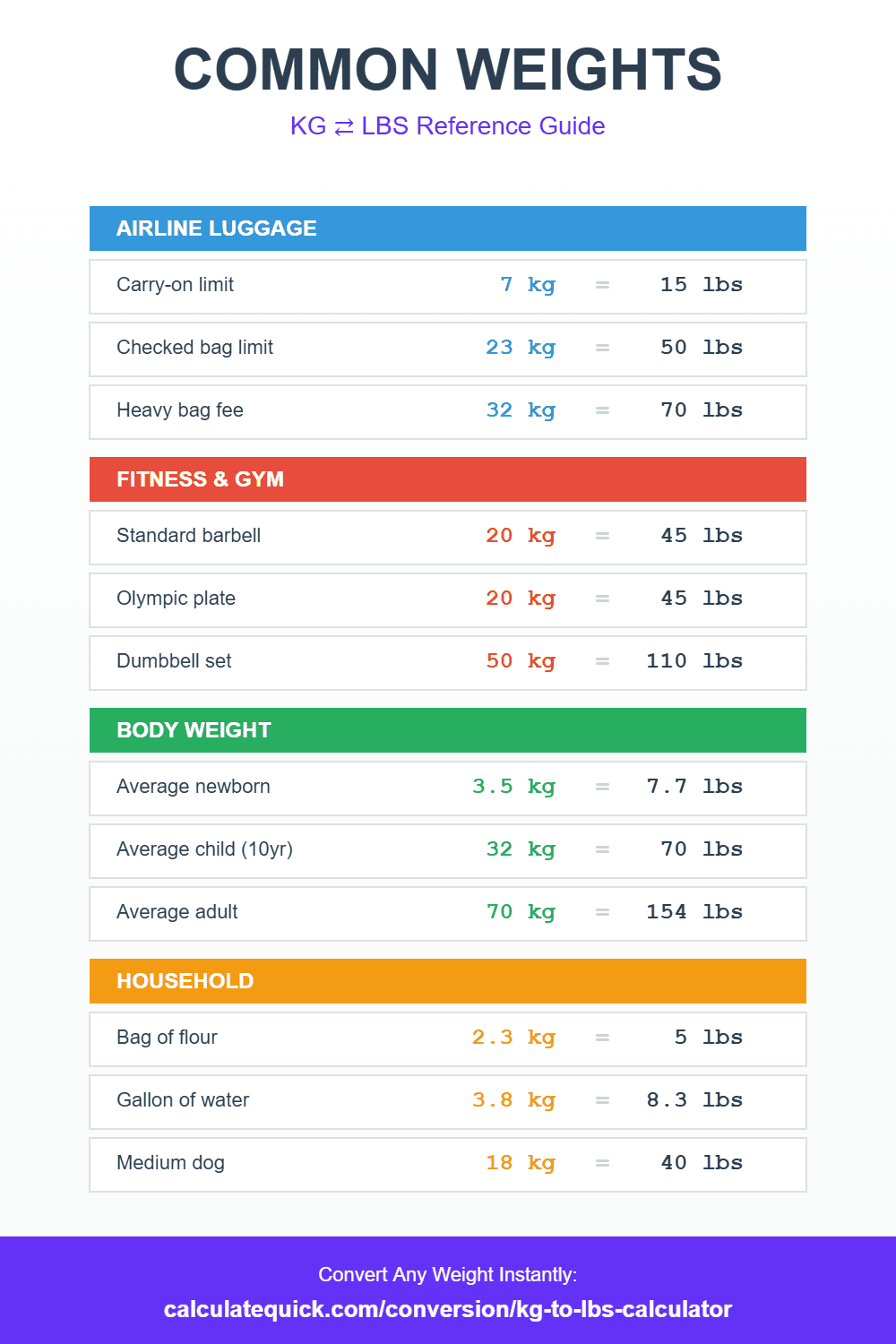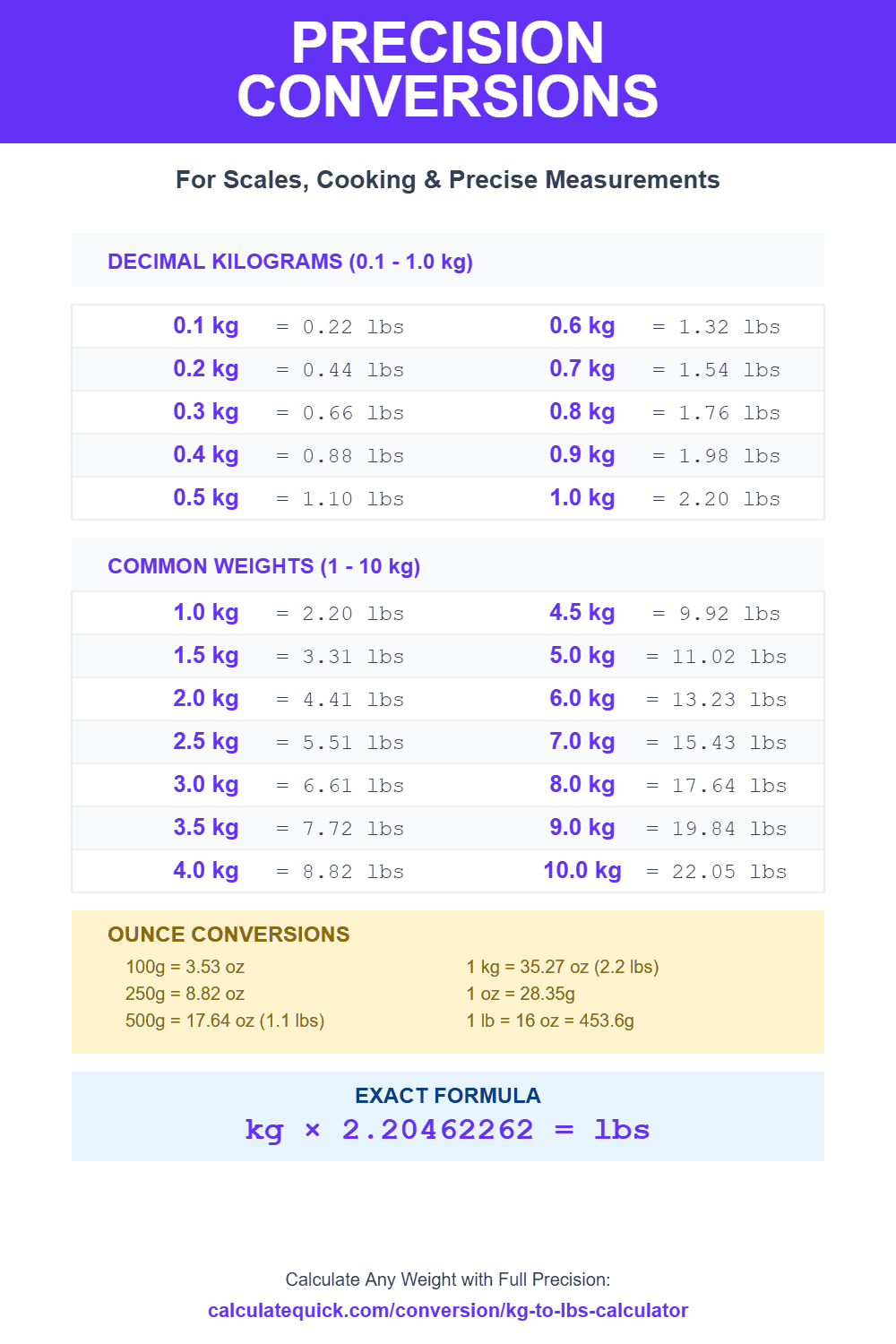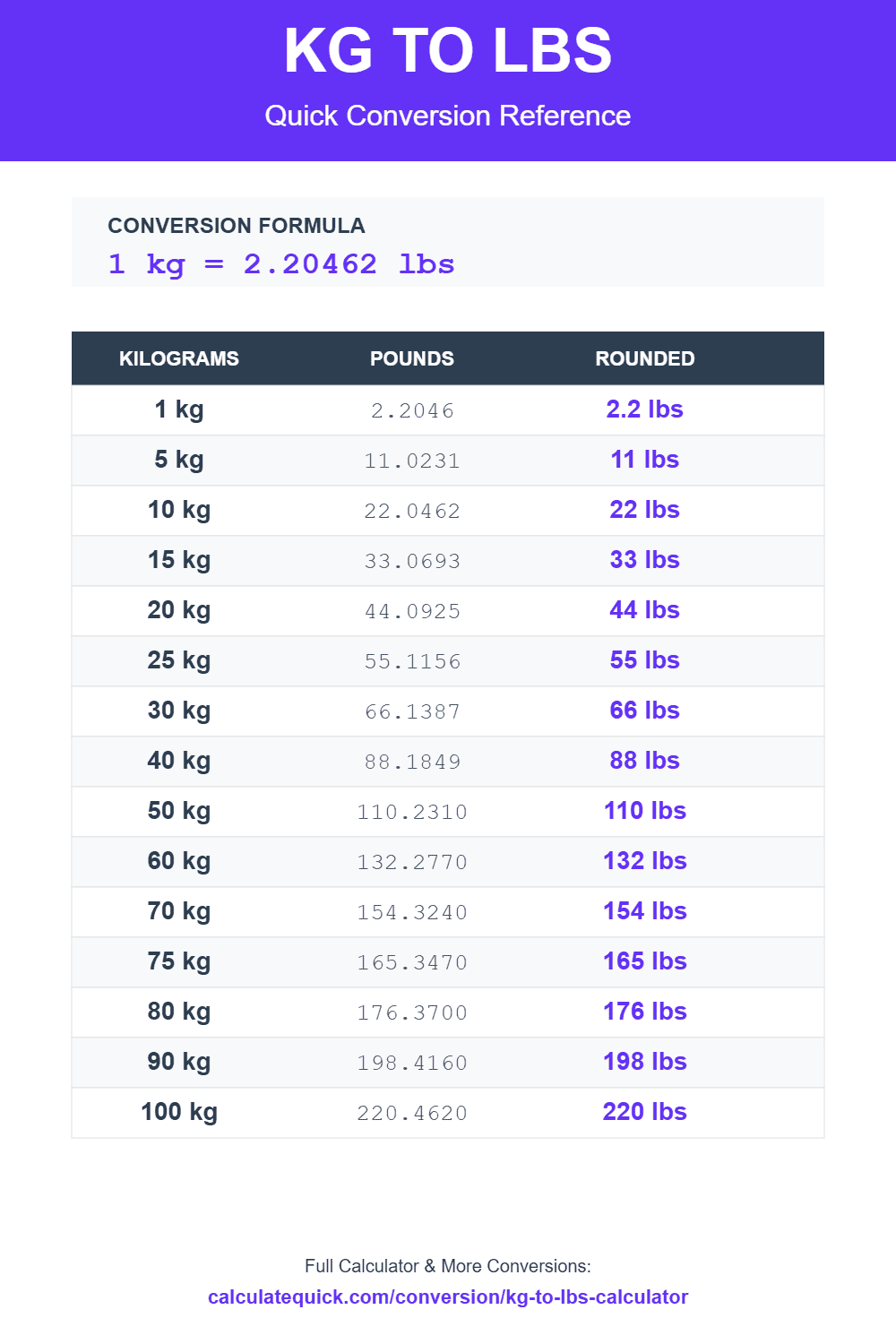Recent Conversions
Conversion Formula: kg × 2.20462 = lbs
Converting kilograms to pounds requires multiplying by 2.20462262185. This exact conversion factor stems from the 1959 international agreement defining one pound as precisely 0.45359237 kilograms. Converting pounds to kilograms uses the reciprocal: multiply by 0.45359237.
Kilograms to Pounds Conversion Table
| Kilograms (kg) | Pounds (lbs) | Calculation |
|---|---|---|
| 1 | 2.20 | 1 × 2.20462 |
| 5 | 11.02 | 5 × 2.20462 |
| 10 | 22.05 | 10 × 2.20462 |
| 20 | 44.09 | 20 × 2.20462 |
| 25 | 55.12 | 25 × 2.20462 |
| 50 | 110.23 | 50 × 2.20462 |
| 70 | 154.32 | 70 × 2.20462 |
| 90 | 198.42 | 90 × 2.20462 |
| 100 | 220.46 | 100 × 2.20462 |
Pounds to Kilograms Conversion Table
| Pounds (lbs) | Kilograms (kg) | Calculation |
|---|---|---|
| 1 | 0.45 | 1 × 0.45359237 |
| 10 | 4.54 | 10 × 0.45359237 |
| 25 | 11.34 | 25 × 0.45359237 |
| 50 | 22.68 | 50 × 0.45359237 |
| 100 | 45.36 | 100 × 0.45359237 |
| 150 | 68.04 | 150 × 0.45359237 |
| 200 | 90.72 | 200 × 0.45359237 |
Stone to Kilograms and Pounds
The stone unit equals 14 pounds exactly, approximately 6.35029 kilograms. British and Irish populations commonly use stone for human body weight. One stone equals 14 pounds, making conversions straightforward: multiply stone by 14 for pounds, or multiply stone by 6.35029 for kilograms.
| Stone | Pounds | Kilograms |
|---|---|---|
| 8 st | 112 lbs | 50.8 kg |
| 10 st | 140 lbs | 63.5 kg |
| 12 st | 168 lbs | 76.2 kg |
| 14 st | 196 lbs | 88.9 kg |
| 16 st | 224 lbs | 101.6 kg |
British medical records and weight discussions commonly express weight in stone and remaining pounds. Someone weighing 11 stone 7 pounds weighs 161 pounds total, calculated as (11 × 14) + 7 = 161 pounds, equivalent to 73 kilograms.
Airline Baggage Weight Requirements
Airlines specify baggage weight limits differently by region. International carriers typically use kilograms for weight limits. US domestic airlines often use pounds. Standard international economy checked baggage allows 23 kilograms (50.7 pounds). Business class typically permits 32 kilograms (70.5 pounds) per bag.
Standard Baggage Limits by Class
| Class | Kilograms | Pounds |
|---|---|---|
| Economy | 23 kg | 50.7 lbs |
| Business | 32 kg | 70.5 lbs |
| First Class | 32 kg | 70.5 lbs |
| Carry-on | 7-10 kg | 15-22 lbs |
Budget airlines often impose stricter limits, typically 15-20 kilograms (33-44 pounds) for checked bags. Excess baggage fees apply per kilogram or per pound over the limit. International flights between metric and imperial countries require travelers to understand both measurement systems to avoid unexpected fees at check-in.
Body Weight Measurement Standards
Medical facilities use different weight units by country. US hospitals record patient weight in pounds. European and most international healthcare systems use kilograms exclusively. Medical research and pharmaceutical dosing calculations worldwide use metric units regardless of the country where treatment occurs.
Body mass index (BMI) calculations require consistent units. The metric formula divides weight in kilograms by height in meters squared. The imperial formula divides weight in pounds by height in inches squared, then multiplies by 703. Mixing units produces incorrect results. A person weighing 70 kilograms (154 pounds) with height 1.75 meters (69 inches) has BMI of 22.9 using either system with correct formulas.

Shipping Weight Calculations
International shipping requires weight specifications in appropriate units for origin and destination countries. Major carriers accept weights in either kilograms or pounds but calculate rates using their system preference. Small conversion discrepancies affect shipping tier pricing, particularly near tier boundaries.
Postal services maintain strict weight limits. USPS Priority Mail International has maximum weights between 20-70 pounds depending on destination. International postal services typically limit parcels to 20-30 kilograms. E-commerce sellers shipping globally must provide accurate weights in both systems for rate calculation and customs documentation.
Freight shipping classifies packages differently than parcel services. Packages under 150 pounds ship as parcel freight. Heavier shipments require LTL (less-than-truckload) freight with rates per hundredweight (100 pounds) in the US. International freight uses per-kilogram or per-metric-tonne rates.
Precision Requirements by Application
Different applications require different precision levels. Home bathroom scales typically measure to 0.1 kilogram or 0.2 pound increments. Commercial shipping scales measure to 0.01 kilogram precision. Laboratory analytical balances measure to 0.0001 gram (0.0000001 kilogram) precision for scientific applications.
Required Measurement Precision
| Personal Body Weight | ±0.1 kg / ±0.2 lbs |
| Baggage/Luggage | ±0.5 kg / ±1 lb |
| Commercial Shipping | ±0.01 kg / ±0.02 lbs |
| Food Portions | ±1 g / ±0.05 oz |
| Laboratory Analysis | ±0.0001 g / ±0.000002 oz |
Rounding during conversion can affect results near category boundaries. A bag weighing 22.8 kilograms rounds to 50 pounds, staying within most airline limits. The exact conversion yields 50.3 pounds, but airlines typically accept reasonable rounding. Maintain full precision during multi-step calculations and round only final results.

Metric System Adoption History
France introduced the metric system in 1795, becoming the first nation to adopt standardized decimal measurement. Most countries transitioned to metric during the 19th and 20th centuries. The United Kingdom began official metrication in 1965 but retained pounds for human body weight and stone measurements in everyday use.
The United States officially recognized the metric system in 1866 through the Metric Act but never mandated its use for commerce or everyday measurement. US industries exporting internationally maintain dual measurement specifications. Scientific research, pharmaceutical manufacturing, and military operations in the US use metric units exclusively while consumer products and daily measurements remain predominantly imperial.
Only three countries have not officially adopted the metric system: the United States, Liberia, and Myanmar. The US remains the only major industrialized nation using imperial measurements for commerce and everyday activities. This creates ongoing need for conversion between systems in international business, travel, and communication.
Manufacturing and Engineering Specifications
Product specifications vary by manufacturing origin. European manufacturers specify component weights in kilograms. American companies use pounds. International standards organizations like ISO primarily use metric units, requiring US manufacturers to maintain dual specifications for export products and international collaboration.
Vehicle specifications list curb weight in pounds for US markets and kilograms elsewhere. A vehicle weighing 1500 kilograms (3307 pounds) has identical mass but different specification sheet numbers by sales region. Import vehicles require conversion of all weight-related specifications including towing capacity, payload ratings, gross vehicle weight rating (GVWR), and axle weight limits.
Construction materials, industrial equipment, and structural components require accurate weight specifications for load calculations, shipping logistics, and installation planning. Engineers working on international projects must convert between systems while maintaining calculation accuracy for safety and regulatory compliance.
